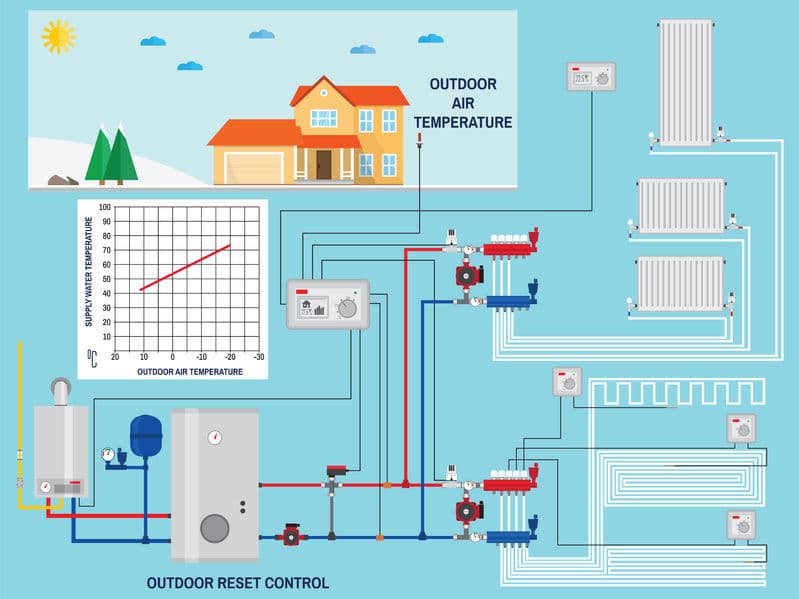How Does A Furnace Work
Winter is about to approach, and through the long months of cold weather, every home depends on a heating system for comfort. Knowing how does a furnace work helps you better understand how to perform some simple troubleshooting and maintenance tasks to prolong the life of your heating system.
Furnaces are also called forced-air furnaces because they direct heated air into different rooms with a blower Fan. However, Furnaces have different fuel sources, such as propane gas, natural gas, oil, or electricity.
If you know the basic working principle of how does a furnace workalos you to have an idea of what could potentially go wrong. You can also quickly point out the problem to a technician during a maintenance call.
What is a Home Gas Furnace System
A majority of homes across Washington have Natural gas-powered home furnace systems. It works by heating air in one area and then distributing the air through a series of ducts and vents installed around the home. Below are the main home gas furnace components.
- Thermostat or control system
- Gas valve
- Burners
- Heat exchanger
- Blower
- Ducts and ventilation
- Flue
Each of these parts plays an integral role in Home Gas Furnace Systems. When there is a problem or issue with a specific part, the entire system could malfunction or work inefficiently.
How Does A Furnace Work
The start cycle of a home furnace starts when the thermostat signals it to turn on. When the furnace receives the signal from the thermostat, the gas valve will open and ignite the burner. The gas valve is also responsible for regulating the amount of gas that goes into the furnace.
One of the most common problems encountered with home furnace systems is the furnace not turning on.

Even if the gas valve is working correctly, this could happen because the pilot light is not turned on.
The manufacturer’s manual contains instructions on how to turn on a pilot light. This same problem can also be due to an issue with the thermocouple or thermopile.
The next step in the heating cycle happens inside the burner. The flames will heat the heat exchanger and circulate the tubes, which then transfer the heat to the air.
A heat exchanger is a vital element of all home furnace systems. If the heat exchanger does not function correctly, you won’t receive any heat. It is also dangerous when a heat exchanger cracks.
The heat circulating the heat exchanger gets pushed through the plenum by the blower. From the plenum, (hot) warm air then gets forced into the ventilation system, coursing through your home. Once the thermostat detects there is enough heat circulating the system, it will automatically shut off the heater.
Natural Gas Furnace Vs. Electric Furnace
Home furnace systems differ according to the fuel used in generating heat. Knowing the benefits of a particular type of fuel source will also help you determine whether your home furnace system. is efficient or not. In most homes today, furnaces are commonly powered by either gas or electricity.
- Electric Furnaces - Electric furnaces are also called air handlers where you can pair them with your existing AC system. The main advantage of an electric furnace is that it can double the purpose and not only heat but also cool your home if necessary. For areas where there is no available natural gas line, an electric furnace may be your best option. However, electric furnaces do not adequately transfer heat, hence uses up a lot of energy.
- Natural Gas Furnace - It is the most typical form of a home furnace system. Similar to an air handler, you can also pair your gas furnace with your air cooling system. Natural gas lines are available in many parts of the country; hence, it is not difficult to install a gas furnace.
Gas furnace home systems provide powerful heat, which is ideal in places where there are long, cold winters. Additionally, natural gas is less expensive than electricity, and you can have year-round heating and cooling if you pair it with your AC system. Gas furnace home systems are also more energy-efficient.
One downside to a gas furnace is the extra precaution needed to detect carbon monoxide. In places where there are no natural gas lines, it is not cost-efficient to choose a gas furnace.
Choosing between a gas furnace and an electric furnace depends on where you live as well as the needs of your home. You can always consult a heating contractor if you are thinking about switching to a different heating system.
Home Furnace Safety and Maintenance Tips
Part of your responsibility in ensuring that your home furnace system is working properly is to take some preventive and safety measures. You don’t need to wait for the annual check-up before assessing your home furnace system for possible issues.
- Before you turn on your home furnace system for winter, you should schedule a maintenance and repair check. If you have a maintenance plan, the technician should come over to check your heating system well before the season starts.
- Check Air filters for dirt build-up and clogs. Ideally, filters need replacement every 90 days. During months of heavy use, you should change filters at least once a month. A pro tip is to write the replacement date on the filter itself so that you know exactly how long it has been since the filter was changed.
- Check the furnace flame color periodically. The ideal color is blue with a small yellow tip. If the color changes to yellow, red, or orange, it is an indication of a burner problem. If this happens, contact a technician right away and never attempt to fix a burner problem yourself.
- If you are using a digital thermostat, you might want to change to a programmable thermostat to save more on your energy bills.
- Anytime you smell gas, don’t turn on any electrical device. Evacuate the home and call a technician right away. Wait for the professional to advise that it is safe to re-enter your home.
- If you hear strange noises or sounds coming from the furnace, it might be an indication of a severe problem. Call a home furnace systems technician as soon as possible.
For comprehensive assistance with your maintenance, repair, and replacement needs in Seattle, Eastside, and surrounding areas
contact us for any additional questions on how a furnace work, give us a call today at 206-202-9499.
